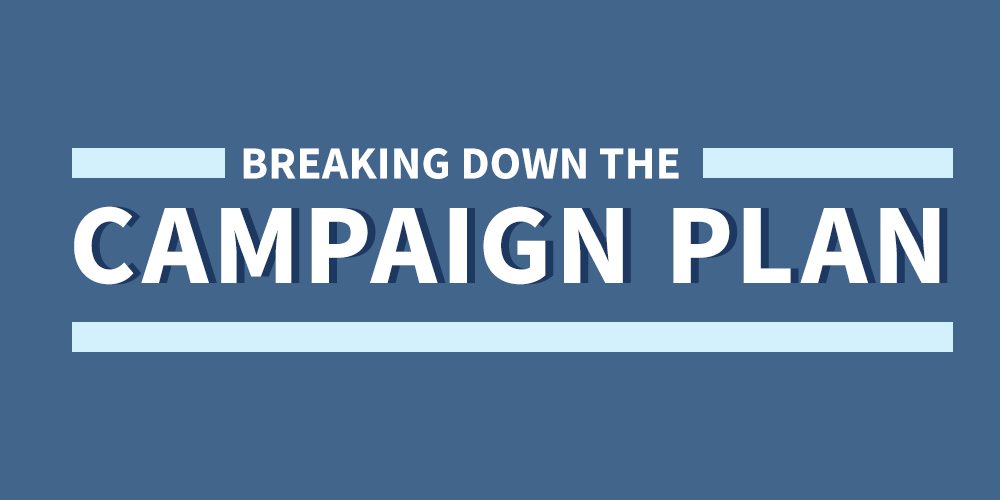The Fundraising Campaign Plan: Why You Need One and How to Create It

Your organization is preparing to launch a campaign – that’s exciting! But are you wondering how you can possibly coordinate and sustain a complex, multi-year, large-scale fundraising effort to achieve a successful result? That’s where your campaign plan comes in.
What is a Campaign Plan?
A campaign plan is a living document that guides the ongoing strategy and actions of all staff and volunteers who are driving the campaign. It includes all important data and information for the campaign. Some of the basic elements that should be included in your campaign plan are:
- Campaign Case Statement
- Needs List by Descriptive Detail and Cost
- Campaign Goals by Purpose, Range and Source
- Progress Report Formats
- Prospect Lists
- Prospect Status Report Formats
- Volunteer Organization Chart
- Job Descriptions
- Campaign Timetable
- Campaign Policies
- Donor Recognition Opportunities
Why Write a Campaign Plan?
A well-crafted campaign plan lays out the specifics of how to proceed and who will be responsible for what tasks. It also prepares you to face both anticipated and unforeseen challenges. Your campaign plan will:
- Make you think ahead. You will be obliged to identify and work through all sorts of details that you might otherwise forget to consider until the eleventh hour – or worse, until after the fact.
- Provide a “road map” to keep you on track. This means that you will be able to look at your timetable to see what you are supposed to be doing now, where you should be in your progress toward goals, as well as what you should be preparing for next.
- Serve as a reference tool to help you evaluate as you progress through your campaign. Sometimes you may have to reevaluate a part of your plan because of a significant event you had not anticipated or a trend you had misjudged. This doesn’t mean that you necessarily have to change your overall goals and objectives, rather that you must review your strategies and tactics (and sometimes your personnel).
How to Start Writing a Campaign Plan
Let’s begin with a few planning principles:
- The plan must be detailed. To be effective, a plan must get down to the granular level, identifying specific steps, timetables, personal responsibilities, and measurement milestones.
- The plan must be flexible. Circumstances keep changing, and your plan must be modified frequently to adapt to those changes.
- The plan won’t be perfect. That’s OK – it still will be an invaluable tool!
Who Should Write the Campaign Plan?
Drafting your plan provides the opportunity to bring together and seek input from the key players and constituencies who will drive the campaign:
- Staff teams who must work together and coordinate their efforts for the campaign to be successful, including development, marketing and communications, and business services. Ask the leaders of these teams to help define the roles they will play, the processes they will drive and their anticipated resource needs.
- Key stakeholders including board members and volunteers who will serve as the lay leaders of the campaign—and will be significant donors as well. They are both the face of the campaign and the target market, so their opinions and reactions will provide an important perspective. Engaging them in the planning process also strengthens their relationship with your organization and gives them ownership and “insider” buy-in to the campaign goals.
Increasing the diversity of voices and perspectives you include will help you craft a strong campaign plan.
Some organizations formalize the process by putting together a campaign planning task force focused on ensuring that preparation for the campaign is thorough and complete. (Many of the members will go on to play key roles in the campaign, especially because of their participation in the planning process.)
Using the Campaign Plan
Your campaign plan will not be helpful unless you actually use it as a resource and road map! There should be a master copy of the document saved on a drive that all key players can access, so that everyone is working from the latest version. There is no substitute for everyone having the same information at the same time.
It is important to identify a Campaign Manager who can focus on coordinating the campaign’s operations, including overseeing the execution of the campaign plan and monitoring of progress. The campaign manager may be a professional development officer, the chief executive officer (where there is no development officer at the institution), or a volunteer. Given the many and diverse responsibilities of the CEO, especially during a capital campaign, it is most valuable to have someone else serve as the campaign manager if possible.
The Campaign Executive Committee should meet regularly to review progress against the goals and timetable set out in the campaign plan and make adjustments as necessary. It is the responsibility of the Campaign Manager to coordinate that process and to make certain that all necessary and relevant information, including the latest input from staff and volunteers, is assembled for those meetings.
Future Benefits of your Plan
By the end of the effort, your campaign plan will probably will constitute the single most complete record of the campaign’s activity and accomplishments. Thus, it also will serve as a history for careful study and continuous reference the next time your organization decides to undertake a comprehensive or capital campaign.


Comments
Questions or comments? Join the conversation!